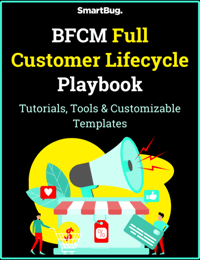
Email Segmentation Strategies for Hyper-Targeted BFCM Campaigns: Maximizing Relevance
October 7, 2024
Also known as list segmentation, email segmentation happens when you organize email recipients into tight, targeted groups so you can send them information that will be relevant to them. The smaller the segments get, the more direct your content can be.
If you treat your email segmentation right, you’re ultimately treating your subscribers to hyper-relevant emails that highlight what they’re actually interested in, thereby leading to more conversions, sustainable purchases, and happier customers. Email segmentation should ultimately have a positive effect on both open rates and click-through rates. It will also help you remove dead emails and unengaged subscribers from your list to improve your email deliverability.
Why Hyper-Targeting Matters During BFCM
Email segmentation should always be at the forefront of your e-commerce marketing strategy. However, using this tactic to maximize relevance and engagement during Black Friday and Cyber Monday (BFCM) campaign planning is especially important for getting noticed during the world’s busiest time for online shopping.
Implementing deliverability best practices to maximize success during BFCM includes creating content that will captivate your audience and provide value. This content should not be one-size-fits-all. Instead, take time to tailor emails for the engagement segments you’ve established.
We marketers know how overwhelmed people can get with sales and promotional emails during BFCM season. Sending a recipient sales or promotions that are relevant to them means you’re more likely to see a conversion than sending one generic sales email to everyone. Makes sense, right?
Essentially, segmentation helps reduce the clicks required to purchase a product and makes the experience that much easier for the recipient to feel like they scored a good deal on something they actually want.
Collecting Customer Preferences
There are several ways to segment your subscribers—such as the four key ways we highlight below—but keep in mind you can also ask your subscribers to segment themselves, in a sense, by letting them tell you about their preferences at appropriate times. This could be a pop-up that appears while they are browsing on your website and asks them which products they like the most, or it could be a simple email quiz asking them to select which content they want to see more or less of in their inbox. All of this produces useful data you can use to your advantage during BFCM.
If you’re interested in collecting important data this way, Justuno’s integration with Klaviyo and Shopify lets businesses boost their data analysis capabilities with custom fields. This level of personalization enables businesses to better tailor their marketing messages to specific customer segments, fostering deeper connections and increasing the likelihood of conversion.
Key Email Segmentation Strategies for BFCM
You’ve got great data on your customers’ preferences and your segmentation is ready to go. Now let’s apply it all to BFCM. The following strategies are applicable for all industries as we head into the busiest shopping season of the year.
1. Demographic Segmentation
This segment divides the market based on variables such as age, income, education, occupation, and family size. Understanding the basic profile of your users is helpful because you can approach them in a way that’s comfortable rather than offputting.
Example: Send targeted emails with offers that resonate with different age groups. For younger demographics, highlight tech gadgets, fashion, or trendy items. For older demographics, emphasize comfort, practicality, or luxury.
Recommendations: Personalize offers based on demographic data. You can collect this data by setting up a simple quiz and sending it to your most engaged segments. Use language and visuals that appeal to the specific demographic. For instance, use energetic, youthful language for younger audiences and a more refined, formal tone for older ones.

2. Geographic Segmentation
This segment is based on where customers live or work and can be as broad as a country or as narrow as a neighborhood. It helps to tailor marketing strategies to the specific needs of different locations.
Example: If certain regions have specific shopping behaviors or climate-based needs (for instance, winter apparel in colder regions), tailor your product recommendations accordingly.
Recommendations: Customize offers based on location. Offer location-specific promotions, such as free shipping or extended delivery options for certain areas. If relevant, include local events or highlight stores participating in BFCM promotions.

3. Psychographic Segmentation
This segment goes beyond demographics and geographic factors to consider the lifestyles, values, interests, and personality traits of users. It helps to align products and services with customers’ psychological attributes.
Example: For environmentally conscious consumers, highlight sustainable products or eco-friendly practices in your BFCM deals. For luxury-oriented segments, focus on exclusive, high-end items with a touch of elegance and sophistication.
Recommendations: Align your messaging with the lifestyles and interests of different psychographic groups. Craft messages with emotional appeals that resonate with their values. This could mean promoting exclusivity, sustainability, or innovation, depending on their psychographic profile.

4. Behavioral Segmentation
This segment focuses on how users interact with products or services, including their purchasing behavior, usage rate, brand loyalty, and benefits sought. It helps to identify and target users based on their actual behavior, rather than just their characteristics.
Example: For frequent buyers, offer early access to BFCM specials or additional discounts as a reward for their loyalty. For those who have browsed specific products but have not purchased, send reminder emails with special BFCM discounts on those items.
Recommendations: Target subscribers based on previous behaviors and interactions with your brand. Use behavioral data to create dynamic content within emails, such as product recommendations based on past purchases or reminders of items left in the cart, incentivized with a BFCM discount.

General Tips Across All Segments
Regardless of how you decide to organize your email segmentation strategies, these tips can help you elevate your BFCM efforts for your whole contact list.
Timing: Start prepping for a successful BFCM months ahead of time by engaging with both dormant and active audiences. Plan your email sends strategically to coincide with peak shopping hours in each segment’s time zone.
Urgency: Use countdowns and limited-time offers to create a sense of urgency. This is especially effective in BFCM campaigns.
Clear CTAs: Make sure your calls to action are strong and tailored to the specific desires of each segment (e.g., “Shop Now for Exclusive Deals,” “Unlock Your Eco-Friendly BFCM Savings”).
Monitoring and Optimizing Segments
Once you decide on your segments, remember to test, test, and test again. Measure open rates and conversions to see if your email segments are responding well to more targeted campaigns. A/B test everything from subject lines and CTAs to hero images and button colors.
Use a unified data and marketing automation platform, such as Klaviyo, to track the performance of your segments so you can make adjustments accordingly. Seeing what resonates best with each segment is an ongoing, exciting experiment! And remember: However your segments behave during this BFCM season, you’ll gather more data to build even more relevant strategies next year.
Next Steps
If you’re wondering how to help your e-commerce store reap the benefits of BFCM by implementing expert email segmentation and other tried-and-true practices, consider reaching out to our SmartBug team to chat about your goals and how we can help you reach them. Our team of Klaviyo experts can help you lean into the right marketing strategies well ahead of BFCM, so you can be more prepared—and, ultimately, more profitable.

Tutorials, Tools, & Customizable Templates
Skyrocket BFCM revenue with our Full Customer Lifecycle Playbook

About the author
Emily Bongiovanni is an E-Commerce Marketing Strategist at SmartBug. She has a passion for driving growth and delivering exceptional results with data-driven strategies. With over 8 years of experience in the dynamic world of marketing, she has a proven track record of helping businesses excel in the digital realm. When she's not strategizing or analyzing, you can find her walking her Australian Shepherd, hiking, or tackling a DIY project at home. Read more articles by Emily Bongiovanni.




